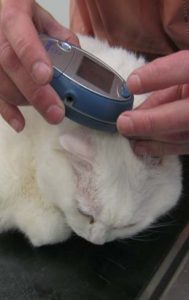Ron Hines DVM PhD
 Normal Blood & Urine Values For Your Pet
Normal Blood & Urine Values For Your Pet
 Causes Of Most Abnormal Blood & Urine Tests
Causes Of Most Abnormal Blood & Urine Tests

Your Dog And Cat’s Blood Sugar Level = Glucose, GLU
Your pet’s blood sugar level (glucose level) needs to remain in a narrow corridor, or bad things begin to happen.
Glucose (dextrose is a form of glucose) is the primary fuel that runs your pet’s body (Fatty acids can also provide some fuel energy). Without sufficient blood glucose (=hypoglycemia), cells cannot live very long. With too much blood glucose (the common cause being diabetes mellitus) the body begins to rely on fats rather than glucose to meet its energy needs (=ketoacidosis).
If blood glucose remains high in your pet; with time, urinary tract infections, decreased disease resistance, kidney failure, nerve-related weakness (neuropathies) and eye damage can occur.
Reasons Why Your Pet’s Blood Glucose Level Could Be Too High (hyperglycemia):
Stress and excitement – especially in cats and toy dog breeds, is the most common cause of a single high reading.
When your pet’s lab glucose values are repeatedly high in a non-stressed situation, diabetes mellitus and Cushing’s disease are the most common causes.
Corticosteroid tablets or injections, acute pancreatitis, IV fluids containing dextrose or a blood samples collected too soon after eating (postprandial blood sample) can all cause the glucose level to be high.
Glucose levels can be moderately elevated in dogs for up to 2 months after their last heat cycle or during pregnancy (the period that their progesterone levels are high).
Abnormally high levels of another pancreatic hormone, glucagon, due to a rare tumor called a glucagonoma has been known to raise blood sugar levels.
Kidney failure (in cats, or in dogs) sometimes results in high glucose levels for reasons that are unclear. The same thing occasionally happens in hyperthyroid cats.
Medications (morphine, epinephrine, thyroxine, xylazine, megesterol acetate, Depo-Povera, beta blockers, niacin etc.) have been known to raise blood glucose levels as well.
A disease of the pituitary gland in cats (acromegaly) that produces too much growth hormone can also raise blood glucose levels.
In humans, documented reasons for elevated blood glucose levels are corticosteroid administration, the use of quinolone antibiotics, anti-psychotic medications, beta blockers, calcineuron inhibitors like cyclosporin, protease inhibitors and thiazide diuretics. These drugs might affect your dog or cat’s blood sugar level similarly.
Reasons Why Your Dog Or Cat’s Blood Glucose Level Could Be Too Low (hypoglycemia):
The most common cause is an overdose of injectable insulin. But too much insulin (hyperinsulinism) due to pancreatic tumors (insulinomas) can have the same effect.
Addison’s disease (hypoadrenocorticism), hypothyroidism, digestion/ absorption problems (malabsorption/maldigestion), starvation and liver disease have also been known to lower blood glucose levels. When your pet’s liver is the underlying cause of low blood sugar, ALT, AST and bilirubin levels will usually be elevated while BUN, albumin and cholesterol will be low. Kittens and puppies need to eat frequently to maintain normal blood glucose levels. So even a short fast can produce low blood sugar levels in newborns. Mature toy breeds sometimes experience the same fasting low blood sugar phenomenon.
Severe bacterial infection, misdirected liver blood flow (portosystemic shunts), severe exertion (e.g. hypoglycemia in lean hunting dogs) and poorly managed diabetes that has progressed to ketosis can also cause blood glucose levels in dogs and cats to be low.
Blood samples that sat too long at the lab before analysis or were collected in the wrong cap color tubes will show falsely low glucose levels.
The ingestion of sufficient Xylitol will also drop a pet’s blood glucose level.
In humans, drugs associated with low blood glucose levels are insulin injections, as well as other drugs like biguanides and sulfoureas used in the treatment of diabetes, ACE inhibitors. Beta blockers, quinolone and chloramphenicol antibiotics can cause both high and low blood glucose levels. Disopyramide, ethanol and salicylates like aspirin have also been associated with low blood glucose levels. These drugs might affect dogs and cat blood sugar levels similarly.

Falsely low blood glucose level (Pseudo-hypoglycemia) is occasionally due to blood collection errors. If the blood sample is allowed to clot in the collection test tube, the clot and the serum portions must be separated within 30 minutes. If more time passes, the glucose in the sample will slowly be absorbed by the cells present in the clot (10%/hour at room temperature). Even faster if your pet has an elevated WBC count. That problem also exists when blood samples with anticoagulants such as EDTA are sent to distant central laboratories for processing. Traffic jams, hot weather, inclement weather, etc. can mean long transit times, during which the glucose in your pet’s blood sample is consumed by the still-living cells in the blood sample. Serum separator tubes (ie marble or tiger top tubes) minimize that problem when centrifuged at the animal hospital before shipment.
Complementary Tests:
Repeat the blood glucose test to confirm accuracy, Urine glucose determination, Blood fructosamine level, ACTH stimulation test, amylase and specific lipase levels (cPL or fPL), blood glucose curve, glycosylated hemoglobin levels, insulin levels, bile acids For low blood glucose, ALT, AST, bilirubin to evaluate liver function.
DxMe


